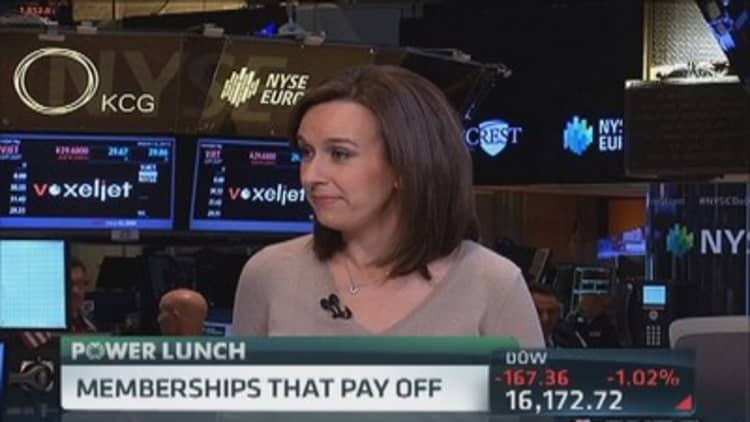
The price of free shipping is going up for Amazon Prime members.
Amazon.com announced Thursday it will raise the price of its Amazon Prime program to $99 from $79 per year, while students will pay $49, up from $39. Members get unlimited free two-day shipping on eligible items, free streaming of movies and TV episodes, and free e-book borrowing from Amazon's library of more than 475,000 titles.
New members have until March 20 to sign up at the $79 price point, according to the membership page, while current members will see the price increase to $99 at their next renewal. The exception: Members whose accounts are set to renew before April 17 will be charged $79.
"It's indicative of tremendous demand, for them to feel like they can raise the cost $20 a year, which is not an insignificant amount," said Douglas Green, principal at MSC, a retail advisory firm based in Philadelphia. "That's a 25 percent increase."
(Read more: Amazon Prime membership could be a budget-buster)
Breaking even with Prime
| Product<br>Category | Shipment price <br>per order | Shipment price<br> per item | # of orders<br> to break even |
|---|---|---|---|
| Video games | $5.99 | $1.99 | 13 |
| Apparel and shoes | $7.99 | $1.99 | 10 |
| DVDs and Blu-ray | $6.99 | $1.99 | 12 |
| Sports | $11.99 | $0.99/lb | 1 (for a set of 45 lb dumbbells) |
| Tools & hardware | $9.99 | $0.99/lb | 1 snowblower weighing at least 90 lbs |
| Luggage | $7.99 | $0.59/lb | 5 (for a 25 lb bag) |
Source: Source: CNBC reporting based on Amazon.com’s two-day shipping rate for continental U.S.
Emails sent to Prime members Thursday attribute the price increase to added benefits and rising costs over the years.
"Even as fuel and transportation costs have increased, the price of Prime has remained the same for nine years," Amazon told members in the email. "Since 2005, the number of items eligible for unlimited free Two-Day Shipping has grown from one million to over 20 million. We also added unlimited access to over 40,000 movies and TV episodes with Prime Instant Video and a selection of over 500,000 books to borrow from the Kindle Owners' Lending Library."
An Amazon.com spokeswoman said members will see more Prime eligible items and other benefits. "We are working to expand selection even further, as we develop additional fulfillment and transportation capacity to make the Prime program even more valuable to our members," she said.
The price hike is likely to slow the flow of new sign-ups, said Mike R. Levin, partner and co-founder of Consumer Intelligence Research Partners. By the firm's estimates, Prime had some 25 million members at the end of January. "Our data indicates that it will likely slow their growth a little bit," he said. "It's been growing like a weed and this will probably slow it down slightly."
But the higher price could also prompt members to spend more at Amazon, to justify their membership. Amazon Prime members spend an average $1,340 with the site each year, reports CIRP, while Kindle device owners spend $1,233 and Amazon Visa cardholders rack up $1,529. Customers without any of those spend an average $529.
Paying an extra $20 a year shifts the value of Prime slightly. Under the $79 price tag, just the value of Prime's streaming video beat Netflix's cost for a streaming video subscription by $16.88 per year. Now, it's $3.12 more expensive than 12 months of Netflix, although the companies' different libraries of titles may still make Amazon more valuable for some viewers.
(Read more: Which membership pays off, AAA or Amazon?)
Prime members in it for the shipping will need to order a little more to break even. Amazon has a complex system of shipping fees that vary by category and number of items per order, with two-day shipping rates starting at $5.99 to $12.49 per shipment. By that measure, at $79 a year, Prime paid off in as few as seven single-item orders or as many as 14. After the price hike, it will take eight to 17. (Shoppers placing big orders, or ones with heavy items that would carry a per-pound charge would reach the break-even point faster.)
Still, that's a quick payoff for many consumers, coupled with the site's competitive pricing, said Green. "At the end of the day, on pure economics, it's hard for bricks and mortar to compete," he said.
Members may also want to gauge shipping speed. According to StellaService.com, from July to December in 2013, Amazon's average standard shipping got orders to customers within roughly 3.5 days, meaning Prime members aren't necessarily gaining much ground.
Although Amazon didn't announce any new Prime perks as part of the price increase, Levin said the benefits are probably not far behind. "They're going to continue to sweeten the benefits to soften the blow," he said. The site is reportedly working on a music-streaming service, for example, and its Amazon Fresh grocery delivery service is poised to expand. Of course, the latter carries an even higher price tag of $299 per year.
—By CNBC's Kelli B. Grant. Follow her on Twitter @Kelligrant and on Google.


